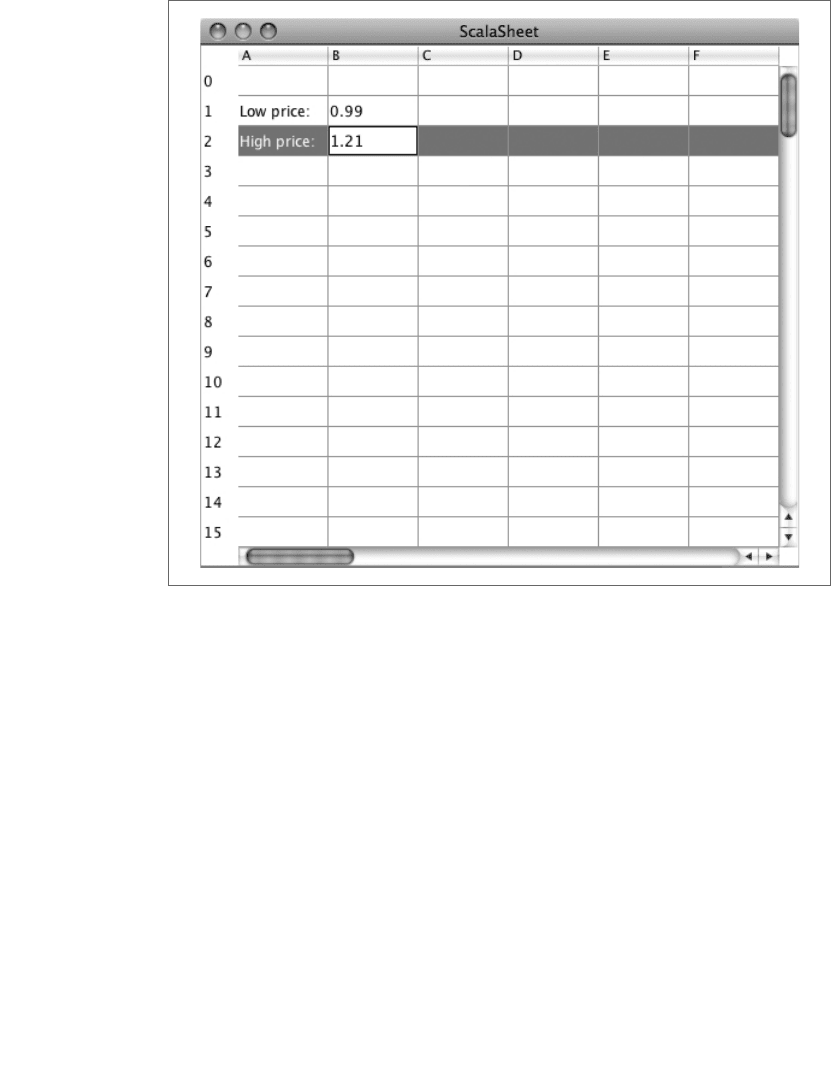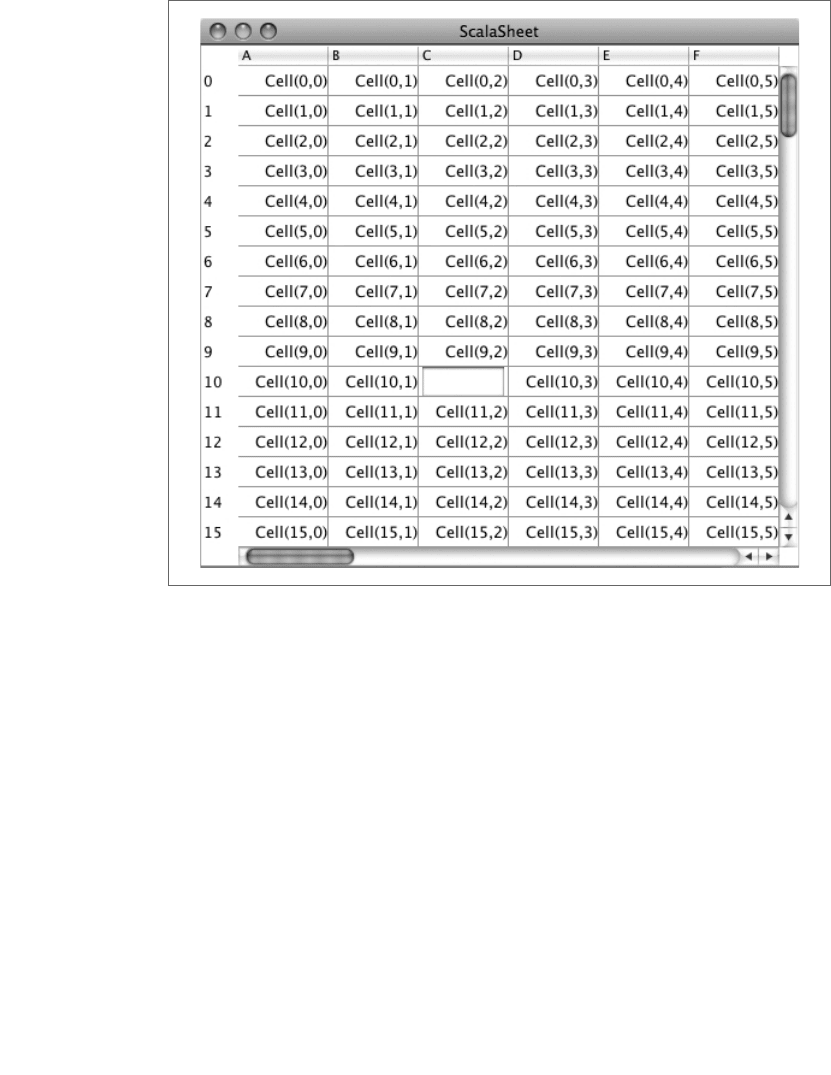Odersky M. Programming in Scala
Подождите немного. Документ загружается.


Section 32.5 Chapter 32 · GUI Programming 681
one after another, in one or more rows, depending on the width of the frame.
The reactions of TempConverter are defined by a handler that con-
tains two cases. Each case matches an EditDone event for one of the two
text fields. Such an event gets issued when a text field has been edited by
the user. Note the form of the patterns, which include back ticks around the
element names:
case EditDone(`celsius`)
As was explained in Section 15.2, the back ticks around celsius ensure that
the pattern matches only if the source of the event was the celsius object. If
you had omitted the back ticks and just written case EditDone(celsius),
the pattern would have matched every event of class EditDone. The changed
field would then be stored in the pattern variable celsius. Obviously, this is
not what you want. Alternatively, you could have defined the two TextField
objects starting with upper case characters, i.e., Celsius and Fahrenheit.
In that case you could have matched them directly without back ticks, as in
case EditDone(Celsius).
The two actions of the EditDone events convert one quantity to another.
Each starts by reading out the contents of the modified field and converting it
to an Int. It then applies the formula for converting one temperature degree
to the other, and stores the result back as a string in the other text field.
32.5 Conclusion
This chapter has given you a first taste of GUI programming, using Scala’s
wrappers for the Swing framework. It has shown how to assemble GUI com-
ponents, how to customize their properties, and how to handle events. For
space reasons, we could discuss only a small number of simple components.
There are many more kinds of components. You can find out about them by
consulting the Scala documentation of the package scala.swing. The next
section will develop an example of a more complicated Swing application.
There are also many tutorials on the original Java Swing framework, on
which the Scala wrapper is based.
1
The Scala wrappers resemble the under-
lying Swing classes, but try to simplify concepts where possible and make
them more uniform. The simplification makes extensive use of the proper-
ties of the Scala language. For instance, Scala’s emulation of properties and
1
See, for instance, The Java Tutorials. [Jav]
Cover · Overview · Contents · Discuss · Suggest · Glossary · Index

Section 32.5 Chapter 32 · GUI Programming 682
its operator overloading allow convenient property definitions using assign-
ments and += operations. Its “everything is an object” philosophy makes
it possible to inherit the main method of a GUI application. The method
can thus be hidden from user applications, including the boilerplate code for
setting things up that comes with it. Finally, and most importantly, Scala’s
first-class functions and pattern matching make it possible to formulate event
handling as the reactions component property, which greatly simplifies life
for the application developer.
Cover · Overview · Contents · Discuss · Suggest · Glossary · Index

Chapter 33
The SCells Spreadsheet
In the previous chapters you saw many different constructs of the Scala pro-
gramming language. In this chapter you’ll see how these constructs play
together in the implementation of a sizable application. The task is to write
a spreadsheet application, which will be named SCells.
There are several reasons why this task is interesting. First, everybody
knows spreadsheets, so it is easy to understand what the application should
do. Second, spreadsheets are programs that exercise a large range of differ-
ent computing tasks. There’s the visual aspect, where a spreadsheet is seen
as a rich GUI application. There’s the symbolic aspect, having to do with
formulas and how to parse and interpret them. There’s the calculational as-
pect, dealing with how to update possibly large tables incrementally. There’s
the reactive aspect, where spreadsheets are seen as programs that react in
intricate ways to events. Finally, there’s the component aspect where the ap-
plication is constructed as a set of reusable components. All these aspects
will be treated in depth in this chapter.
33.1 The visual framework
We’ll start by writing the basic visual framework of the application. Fig-
ure 33.1 shows the first iteration of the user interface. You can see that a
spreadsheet is a scrollable table. It has rows going from 0 to 99 and columns
going from A to Z. You express this in Swing by defining a spreadsheet as a
ScrollPane containing a Table. Listing 33.1 shows the code.
The spreadsheet component shown in Listing 33.1 is defined in pack-
age org.stairwaybook.scells, which will contain all classes, traits, and
Cover · Overview · Contents · Discuss · Suggest · Glossary · Index

Section 33.1 Chapter 33 · The SCells Spreadsheet 684
Figure 33.1 · A simple spreadsheet table.
objects needed for the application. It imports from package scala.swing
essential elements of Scala’s Swing wrapper. Spreadsheet itself is a class
that takes height and width (in numbers of cells) as parameters. The class
extends ScrollPane, which gives it the scroll-bars at the bottom and right in
Figure 33.1. It contains two sub-components named table and rowHeader.
The table component is an instance of an anonymous subclass of class
scala.swing.Table. The four lines in its body set some of its attributes:
rowHeight for the height of a table row in points, autoResizeMode to turn
auto-sizing the table off, showGrid to show a grid of lines between cells, and
gridColor to set the color of the grid to a dark gray.
The rowHeader component, which contains the row-number headers at
the left of the spreadsheet in Figure 33.1, is a ListView that displays in its
Cover · Overview · Contents · Discuss · Suggest · Glossary · Index

Section 33.1 Chapter 33 · The SCells Spreadsheet 685
package org.stairwaybook.scells
import swing._
class Spreadsheet(val height: Int, val width: Int)
extends ScrollPane {
val table = new Table(height, width) {
rowHeight = 25
autoResizeMode = Table.AutoResizeMode.Off
showGrid = true
gridColor = new java.awt.Color(150, 150, 150)
}
val rowHeader =
new ListView((0 until height) map (_.toString)) {
fixedCellWidth = 30
fixedCellHeight = table.rowHeight
}
viewportView = table
rowHeaderView = rowHeader
}
Listing 33.1 · Code for spreadsheet in Figure 33.1.
elements the strings 0 through 99. The two lines in its body fix the width of a
cell to be 30 points and the height to be the same as the table’s rowHeight.
The whole spreadsheet is assembled by setting two fields in ScrollPane.
The field viewportView is set to the table, and the field rowHeaderView
is set to the rowHeader list. The difference between the two views is that a
view port of a scroll pane is the area that scrolls with the two bars, whereas
the row header on the left stays fixed when you move the horizontal scroll
bar. By some quirk, Swing already supplies by default a column header at
the top of the table, so there’s no need to define one explicitly.
To try out the rudimentary spreadsheet shown in Listing 33.1, you just
need to define a main program that creates Spreadsheet component. Such
a program is shown in Listing 33.2.
The Main program inherits from SimpleGUIApplication, which takes
care of all the low-level details that need to be set up before a Swing applica-
tion can be run. You only need to define the top-level window of the appli-
Cover · Overview · Contents · Discuss · Suggest · Glossary · Index

Section 33.2 Chapter 33 · The SCells Spreadsheet 686
package org.stairwaybook.scells
import swing._
object Main extends SimpleGUIApplication {
def top = new MainFrame {
title = "ScalaSheet"
contents = new Spreadsheet(100, 26)
}
}
Listing 33.2 · The main program for the spreadsheet application.
cation in the top method. In our example, top is a MainFrame that has two
elements defined: its title, set to “ScalaSheet,” and its contents, set to an
instance of class Spreadsheet with 100 rows and 26 columns. That’s all. If
you launch this application with scala org.stairwaybook.scells.Main,
you should see the spreadsheet in Figure 33.1.
33.2 Disconnecting data entry and display
If you play a bit with the spreadsheet written so far, you’ll quickly notice that
the output that’s displayed in a cell is always exactly what you entered in the
cell. A real spreadsheet does not behave like that. In a real spreadsheet, you
would enter a formula and you’d see its value. So what is entered into a cell
is different from what is displayed.
As a first step to a real spreadsheet application, you should concen-
trate on disentangling data entry and display. The basic mechanism for
display is contained in the rendererComponent method of class Table.
By default, rendererComponent always displays what’s entered. If you
want to change that, you need to override rendererComponent to do some-
thing different. Listing 33.3 shows a new version of Spreadsheet with a
rendererComponent method.
The rendererComponent method overrides a default method in class
Table. It takes four parameters. The isSelected and hasFocus parameters
are Booleans that indicate whether the cell has been selected and whether
it has focus, meaning that keyboard events will go into into the cell. The
remaining two parameters, row and column, give the cell’s coordinates.
Cover · Overview · Contents · Discuss · Suggest · Glossary · Index

Section 33.2 Chapter 33 · The SCells Spreadsheet 687
package org.stairwaybook.scells
import swing._
class Spreadsheet(val height: Int, val width: Int)
extends ScrollPane {
val cellModel = new Model(height, width)
import cellModel._
val table = new Table(height, width) {
// settings as before...
override def rendererComponent(isSelected: Boolean,
hasFocus: Boolean, row: Int, column: Int): Component =
if (hasFocus) new TextField(userData(row, column))
else
new Label(cells(row)(column).toString) {
xAlignment = Alignment.Right
}
def userData(row: Int, column: Int): String = {
val v = this(row, column)
if (v == null) "" else v.toString
}
}
// rest as before...
}
Listing 33.3 · A spreadsheet with a rendererComponent method.
The new rendererComponent method checks whether the cell has input
focus. If hasFocus is true, the cell is used for editing. In this case you
want to display an editable TextField that contains the data the user has
entered so far. This data is returned by the helper method userData, which
displays the contents of the table at a given row and column. The contents
are retrieved by the call this(row, column).
1
The userData method also
takes care to display a null element as the empty string instead of “null”.
1
Although “this(row, column)” may look similar to a constructor invocation, it is in
this case an invocation of the apply method on the current Table instance.
Cover · Overview · Contents · Discuss · Suggest · Glossary · Index

Section 33.2 Chapter 33 · The SCells Spreadsheet 688
package org.stairwaybook.scells
class Model(val height: Int, val width: Int) {
case class Cell(row: Int, column: Int)
val cells = new Array[Array[Cell]](height, width)
for (i <- 0 until height; j <- 0 until width)
cells(i)(j) = new Cell(i, j)
}
Listing 33.4 · First version of the Model class.
So far so good. But what should be displayed if the cell does not have
focus? In a real spreadsheet this would be the value of a cell. Thus, there
are really two tables at work. The first table, named table contains what the
user entered. A second “shadow” table contains the internal representation of
cells and what should be displayed. In the spreadsheet example, this table is a
two-dimensional array called cells. If a cell at a given row and column does
not have editing focus, the rendererComponent method will display the
element cells(row)(column). The element cannot be edited, so it should
be displayed in a Label instead of in an editable TextField.
It remains to define the internal array of cells. You could do this directly
in the Spreadsheet class, but it’s generally preferable to separate the view
of a GUI component from its internal model. That’s why in the example
above the cells array is defined in a separate class named Model. The
model is integrated into the Spreadsheet by defining a value cellModel
of type Model. The import clause that follows this val definition makes
the members of cellModel available inside Spreadsheet without having to
prefix them. Listing 33.4 shows a first simplified version of a Model class.
The class defines an inner class, Cell, and a two-dimensional array, cells,
of Cell elements. Each element is initialized to be a fresh Cell.
That’s it. If you compile the modified Spreadsheet class with the Model
trait and run the Main application you should see a window as in Figure 33.2.
The objective of this section was to arrive at a design where the displayed
value of a cell is different from the string that was entered into it. This objec-
tive has clearly been met, albeit in a very crude way. In the new spreadsheet
you can enter anything you want into a cell, but it will always display just its
coordinates once it loses focus. Clearly, we are not done yet.
Cover · Overview · Contents · Discuss · Suggest · Glossary · Index

Section 33.3 Chapter 33 · The SCells Spreadsheet 689
Figure 33.2 · Cells displaying themselves.
33.3 Formulas
In reality, a spreadsheet cell holds two things: An actual value and a formula
to compute this value. There are three types of formulas in a spreadsheet:
1. Numeric values such as 1.22, -3, or 0.
2. Textual labels such as Annual sales, Deprecation, or total.
3. Formulas that compute a new value from the contents of cells, such as
“=add(A1,B2)”, or “=sum(mul(2, A2), C1:D16)”
A formula that computes a value always starts with an equals sign and is
followed by an arithmetic expression. The SCells spreadsheet has a par-
ticularly simple and uniform convention for arithmetic expressions: every
Cover · Overview · Contents · Discuss · Suggest · Glossary · Index

Section 33.3 Chapter 33 · The SCells Spreadsheet 690
expression is an application of some function to a list of arguments. The
function name is an identifier such as add for binary addition, or sum for
summation of an arbitrary number of operands. A function argument can
be a number, a reference to a cell, a reference to a range of cells such as
C1:D16, or another function application. You’ll see later that SCells has an
open architecture that makes it easy to install your own functions via mixin
composition.
The first step to handling formulas is writing down the types that rep-
resent them. As you might expect, the different kinds of formulas are rep-
resented by case classes. Listing 33.5 shows the contents of a file named
Formulas.scala, where these case classes are defined:
package org.stairwaybook.scells
trait Formula
case class Coord(row: Int, column: Int) extends Formula {
override def toString = ('A' + column).toChar.toString + row
}
case class Range(c1: Coord, c2: Coord) extends Formula {
override def toString = c1.toString +":"+ c2.toString
}
case class Number(value: Double) extends Formula {
override def toString = value.toString
}
case class Textual(value: String) extends Formula {
override def toString = value
}
case class Application(function: String,
arguments: List[Formula]) extends Formula {
override def toString =
function + arguments.mkString("(", ",", ")")
}
object Empty extends Textual("")
Listing 33.5 · Classes representing formulas.
The root of the class hierarchy shown in Listing 33.5 is a trait Formula.
This trait has five case classes as children:
Cover · Overview · Contents · Discuss · Suggest · Glossary · Index
